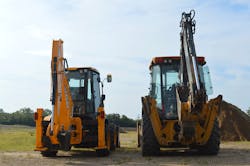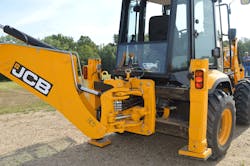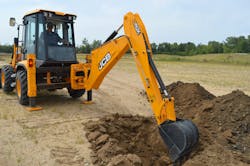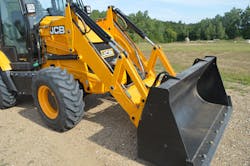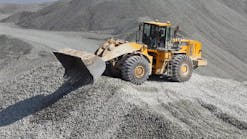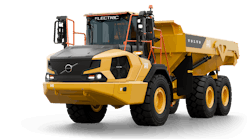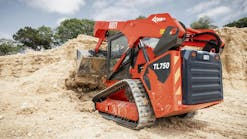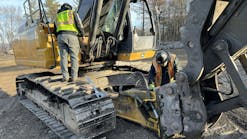Introduced in North America at ICUEE in 2015, the 74-horsepower JCB 3CX Compact backhoe loader targets utility applications, road construction, and urban job sites requiring power and maneuverability in a small package.
The machine is 35 percent smaller than the conventional 3CX backhoe loader and reflects the company’s thinking that modern construction sites will become increasingly congested, particularly in urban areas. The size definitely leads one to do a double take, particularly next to other iron.
The backhoe loader is a mere 8 feet 3 inches high and 6 feet 2 inches wide, and the unit’s four-wheel steering allows a turning circle of just over 19 feet.
“It’s the only construction-grade backhoe loader this size, and not an ag tractor with a backhoe attachment,” says JCB backhoe loader product manager Diego Butzke, who is on hand to review the features and controls before the test.
Butzke says that the unit’s appeal is high with utility companies, cemeteries, and smaller contractors because of the versatility and the chance to replace small loaders and mini excavators.
“Many customers are tired of hauling two machines, having two operators or two crews, so they want one machine that can do it all,” he says. “That’s the benefit of this backhoe and its attachments; you have more than two machines in one. At the same time, you can have one operator who travels with the machine everywhere.”
3CX has a quick hitch for loader attachments
The 3CX Compact backhoe loader is equipped with a skid steer/CTL quick hitch to use any existing skid steer attachment. “We didn’t have the skid steer quick hitch at launch, but we made it available by Conexpo 2017,” Butzke says. “Together with the quick hitch, we delivered skid steer hydraulic couplings so you can engage the same hydraulic couplings from any skid steer.”
Butzke adds that 95 percent of customers order the machine with skid steer couplings. “With more than 100,000 skid steers and CTLs sold here per year, these attachments are all around job sites already.”
JCB engineers knew that hydraulic flow would be important for attachment use. “The 3CX Compact is fully hydrostatic; variable displacement pumps are used to run a closed-center hydraulics system,” Butzke says. “You do have the benefit of increased flow, together with more pressure. so you can run more and different attachments with the system.”
The maximum flow for the backhoe loader is 26 gpm, with 22 gpm available at the couplings, according to Butzke. Also on the loader end, the arms feature four cylinders instead of three. “Two cylinders for the bucket will give you extra breakout force, and also, there’s nothing in the middle of the machine blocking the operator’s view to the loader,” Butzke says.
A parallel loader arm design ensures that the bucket will raise and lower level with the ground. “This is especially important if you’re working with forks,” Butzke says. “It will guarantee the forks stay level going up and down. Many times operators may not be skilled enough to level the load themselves, so in this case the machine will do that for them.” The machine is also equipped with return-to-dig.
“This backhoe is unlike any other backhoe you’ll find in North America,” Butzke says. “The goal is to provide the performance of a larger machine in a small package.”
In part because of the machine’s smaller dimensions, International Union of Operating Engineers Local 649 (Bartonville, Illinois) operator/instructors Bill Cinnamon and Jeff Braun were determined to test its limits.
Loading and roading the JCB backhoe loader
Both operators began the Field Test by charging an unremarkable, but substantial, pile of dirt with the loader bucket. Conditions were hot and dry, and there was no discernible moisture in the pile. With the machine’s size, however, the operators weren’t sure what they were going to experience.
“That’s the first thing with any loader, regardless of size, when you hit a pile you want to see that it’s got the ability to dig its way into the pile,” Cinnamon says. “I noticed really good power going into the pile. I dug into the pile in first and second gear.
“With second, I was able to load adequately with the looser material first,” Cinnamon says. “It was better when I got into the tighter portion of the pile. You look for the ability to spin the tires as you’re going into the pile. That’s not exactly good operation, but you want to see if the machine can do it, so you get it up to that threshold. It was filling the bucket very well. Taking account of the size, it was very comparable [to a larger backhoe loader]. It was loading itself for its size just like you’d expect out of a larger, conventional machine.”
Both operators also drove over a bumpy haul road with a full loader bucket to test the unit’s comfort and material retention.
The JCB 3CX Compact’s standard ride control feature is called the smooth ride loader suspension system (SRS). “If you’re going to move material any distance, it’s well worth the money you spent for it,” Braun says.
“It’s so much easier on the machine itself. When you traverse some rough areas with it on like we did, it floated over those rough-terrain areas. Without it, you probably lost 10 percent going over the rough spots. If you lose 10 percent over 10 loads, you’ve just lost a whole bucket. It’s also much easier on older operators; you’re not getting beat up in the cab,” Braun says.
“I’m from an era where there wasn’t ride control in machinery,” Cinammon says. “It worked really well leveling the ride out on our road.”
Digging with the JCB backhoe
After working the loader end, the Local 649 instructors relished the chance to put the backhoe into the ground and grab some big bites, or at least as big a bite as the standard 18-inch bucket would allow.
The test machine also had a fixed 12-foot dipper. “This machine will dig all the way down to 11 feet 10 inches,” Butzke says. “To get further than that, you can go down to 14 feet 2 inches with an optional extendable dipper.”
Butzke points out that the 3CX Compact’s backhoe boom and dipper are the same length measured from the pin. “Geometrically, that allows you to dig very close with the back end, very close to the king post,” he says. “Many other backhoes have shorter dippers, and it makes them like a ‘T-Rex,’ with short arms. They can’t get closer to the machine when they’re trenching—they have to reposition the machine more times, so they’re actually less productive.”
Cinnamon and Braun each dug a trench and a square box to simulate a manhole dig or a pier hole for a footing. Because of the sideshift backhoe, JCB touts the machine’s ability to dig a square hole without having to reposition the machine. The unit easily performed the task.
“The power seemed nice for that size machine, it comes through the dirt nicely, and I was able to load the bucket,” Braun says. “If you want to make 2-inch passes, it would load the bucket very comfortably. If you were in an area where you wanted to hog material, it would also do that very comfortably without stalling the machine or stalling the hydraulics.”
Cinnamon liked the machine’s standard pilot controls. “They had a good feel,” he says. “A hoe guy is always wanting feedback. The problem with a lot of pilot controls is that you take a lot of that feedback away. When you get to a true pilot system where it’s almost too easy and there’s no feedback to your hands, you’ve truly got no connection between the work and you—it’s almost like you’re running something with remote control. That’s not the issue here.”
Cinnamon also liked the responsiveness and speed. “It was very quick in terms of responsiveness,” he says. “There was little or no lag; of course with the machine being new, it’s tight, but it’s very responsive and I’m assuming that will only stay with the machine throughout its life.”
Braun, however, did notice a small lag—but only in a specific situation he termed a possible “annoyance” rather than a problem for most operators.
“It was okay, but it seemed once you got into a four-function mode, the bucket curl started lacking a little,” Braun says. “If you were in a four-function mode—boom, stick, swing, and then started using your bucket—the curl was what was suffering out of all four functions. Then again, most people aren’t trying to do what I’m trying to do. Under normal circumstances, it probably wouldn’t be a problem.”
Sideshift backhoe versus over center
The vast majority of backhoe loaders sold in North America feature center-mounted backhoe booms and outriggers that spread out horizontally from the machine for stability while digging. As JCB is a worldwide backhoe loader manufacturer with major market share elsewhere in the world, it builds many of its units with sideshift backhoes and vertical stabilizers to accommodate narrow streets, alleys, and job sites. The 3CX Compact is no exception.
After lowering the stabilizers straight down, to slide the backhoe back and forth from one side of the machine to the other using the sideshift feature, the operator must press a button on the dash releasing the hydraclamps on the king post. “Then you use the bucket to push the backhoe to one side or the other,” Butzke says. “The backhoe moves 3 feet 3 inches to each side of the machine. It give you the ability to park the machine almost anywhere and dig that square hole without repositioning the machine.”
It is a feature Cinnamon and Braun had never encountered.
“I thought I would notice a difference digging with [vertical stabilizers], but I didn’t,” Cinnamon says. “The only thing you have to be mindful of is the fact that if you’re digging right up close to the machine, you’re truly digging almost right up under your stabilizer, more so than you would be with a machine where the riggers are out maybe 4 or 5 feet.”
Both Braun and Cinnamon wondered about stability with bucket loads when the backhoe is shifted flush to the left or right.
“The first thing I tried was to see if I could get the machine a little unstable,” says Braun. “With the size of the bucket and the boom configuration, even with the boom all the way to the right or left, it’s still a stable machine. If you know what you’re doing, you keep that load low to the ground, and if something does start to happen, you can lower the load right then and get away from it.”
Braun was impressed with the visibility made possible by the sideshift configuration, and said that he’d use it just for the bonus visibility.
“There’s nothing in your way—particularly when you offset the boom,” he says. “That allows you to get a really nice view, where with a normal backhoe, you’re always looking around the boom to one side or the other. This one, even if you offset it a couple of inches, my goodness, your visibility is great, especially if you’re going down to dig up a known utility line and you’re going to dig on both sides of it. What a neat opportunity,” Braun says.
“Let’s say you’re going down to do a tap on a gas line or something, you could move the [sideshift] backhoe over, dig one side up, sideshift again to the other side, move it past that utility, and dig another nice, easy trench, with the help of your labor, right alongside that utility,” Braun says.
“It makes a nice-looking end product, and it’s easier on us operators because we’ve got good visibility around the boom versus having to move and offset the whole machine one way,” Braun says. “If you have to do that, remember then that you’re disturbing the earth as you add pressure and take pressure away from things, and that tends to do things to your ditch banks.”
Although there are a number of advantages to the sideshift backhoe, including visibility and the ability to dig closer to the machine, both operators noted key differences versus a conventional, over-center backhoe with a standard transmission that could be a concern in some applications.
“The only thing that caught me as different with the sideshift is that with a conventional backhoe loader, in production work, I’m used to lifting the outriggers, sticking the bucket into the ground and shoving yourself forward,” Cinnamon says. “This machine being hydrostatic, I learned real quickly that it’s not going to shove forward. You do have to spin the seat around and roll yourself ahead, which is not a horrible detriment, but those ‘hurry-up-type’ guys are going to want to see something a little quicker.”
Braun says what he would question is the ability to use the backhoe bucket for sideshift movement on an ultratight job site.
“If I’m digging a square box for a manhole in a real tight area, in order to make that [sideshift move], you have to have some room to make that move left or right, almost 90 degrees, to make that functional,” he says. “Otherwise, if you’re right next to Aunt Mary’s front yard, are you going to be able to reach out and put your bucket in that yard just so you can move?
“Same with an alley situation, if you’re right next to a garage or fence, and you’ve got a truck on the other side, it’s going to be pretty tough to make that move. That could be a real detriment,” Braun says.
Operators provide their overall impressions
Both operators were impressed with the backhoe loader’s performance and see applications tailor made for its size.
“I didn’t really notice it was a smaller machine,” Cinnamon says. “You’re hopefully going to be on a job that’s matched to a smaller machine. Now if I had a larger task in front of me, hundreds of feet of pipe, big, deep stuff, you’re going to notice [the size]. If you’re truly matched to what it’s designed for, it will behave just like a larger machine would.”
Braun sees it as a valuable niche machine. “If you’ve got a utility contractor who knows that 50 percent of their stuff is done in alleys, it’s going to be huge for them,” he says. “If you’re going to be digging through a cornfield on a daily basis and want to get more dirt moved, it’s probably not for you. In the real world, we’re going to ask, ‘Can we get a 30-inch bucket on that, we want to move more dirt?’ so that leads to something that maybe this particular machine is not designed to do.”
In short, Braun says it’s about knowing the proper application for the capabilities of the machine.
“It’s fine as long as you understand what you’re doing with the tools you have to work with,” he says. “You don’t take a chainsaw to go do finish carpentry.”
